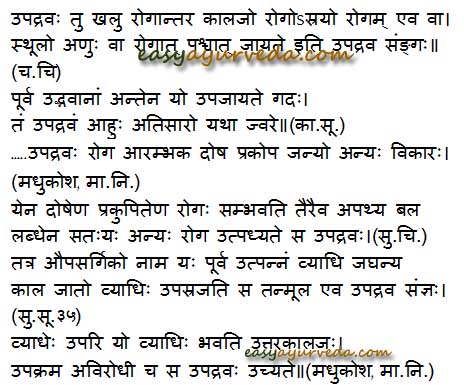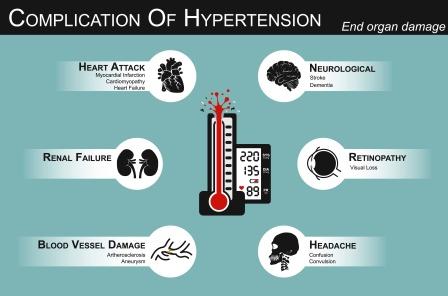Upadrava: Complications of diseases, Definition, Examples
Article by Dr Raghuram Y.S. MD (Ay) & Dr Manasa, B.A.M.S
Upadravas means the complications produced in a disease. Those diseases which have not been addressed in proper time or not diagnosed properly in their earlier stages, lead to complications.

Table of Contents
Upadrava definition
Definition of Upadrava
Complication is a disease which is produced after the formation of the main disease and is dependent on the main disease.
The Upadrava may be a major one or a minor one. Example, Atisaara (diarrhea) is upadrava of Jwara (fever).
Upadrava is the secondary disease or complication produced by the same dosha which is responsible for the formation of the main disease.
When the main disease has been produced and the Doshas responsible for this disease get further vitiated owing to abnormal diet, behavior, lifestyle practices etc, a secondary disease is super added to the already existing one. This super-added disease is called Upadrava.
Upadrava is a secondary disease for which the basic cause (dosha) responsible is the same as in the main disease. It is also called aupasargika roga.

Upadrava is another disease or pathological condition which develops on the back drop of another disease, i.e. in the uttarakala (later period) of the main vyadhi (main disease).
Salient features
Salient features of Upadrava, vis-à-vis Complications of a disease
Upadravas are always formed after the disease – Un-diagnosed, untreated disease condition predisposes and provides an ideal platform for development of Upadravas.
Upadravas may vary proportionally – The complications might be smaller ones or they may be life threatening.
Upadrava can itself be a disease – Complication is also a disease with separate identity. When a complication or Upadrava ‘Y’ gets manifest from a disease ‘X’, the upadrava ‘Y’ may in later time dominate the clinical picture of disease ‘X’ and manifest as an independent disease i.e. Upadrava may manifest as a difficult independent disease masking the existence of the main disease.
Upadrava and the main disease are commonly connected to the same dosha –
Same dosha which causes the disease, is most of the times responsible for the causation of upadrava also.
Example – Kaphaja Kasa (cough caused by morbid kapha) is a complication of Kaphaja Peenasa (Rhinitis or inflammation of nasal mucosa caused by morbid Kapha).
The etiology (nidana) of dosha remains the same for both vyadhi and upadrava – The same etiological factors which vitiate the disease causing dosha are the same for upadravas also because the same dosha which causes the vyadhi also causes the upadrava.
Example Kaphaja Peenasa is caused by vitiation of kapha. This kapha is vitiated by Kapha causes like cold, sweet, sour and salty foods, exposure to cold, clouds and mist etc. These causes remain common for the upadravas also. In fact if these causative factors are consumed even in the presence of the vyadhi, they may take part in the formation of complications by worsening the vyadhi.
Upadrava is dependent – Upadrava or complication of the disease is always dependent (anubandhya) on the main vyadhi, because Upadrava can never manifest independently. Upadrava always is manifested after the main disease has been manifested and is an effect of improperly diagnosed or improperly treated disease. The pradhana vyadhi or the main disease which produces the upadrava is independent (anubandha).
Upadrava generally subsides when the main disease is treated – Generally the Upadrava might not require a separate treatment strategy. It goes away when the main disease (which has caused the upadrava) is treated properly. But it is not a rule. The Upadrava may many times take a serious course and be damaging, more than the main disease from which it is derived. In these cases the Upadrava will manifest with a bigger magnitude and will dominate the picture of the pradhana vyadhi. In these cases Upadrava might demand special attention.
Upadravas have a Samprapti or pathogenesis of their own – Though the Upadravas are caused by the same dosha as in the Pradhana Vyadhi (main disease), it has its own independent dosha dushya sammurchana and Samprapti (pathogenesis). Hence the treatment for Vyadhi (disease) and Upadrava (complication) are not contradictory to each other.
Dosha Dushya Sammurchana is the amalgamation of vitiated dosha and weak (susceptible) dhatu (tissue). When a vitiated dosha gets lodged in a susceptible dhatu, the dosha tends to damage the dhatu and initiate disease process. This is called as Samprapti or pathogenesis (the chain of events leading to the manifestation of the disease).
The Vyadhi will have its individual and unique dosha dushya sammurchana and samprapti. Similarly the Upadrava too will have its individual and unique dosha dushya sammurchana and samprapti, independent of the main disease causing it.
Upadrava persists along with the Vyadhi – Generally the main disease (Vyadhi) persists during the course of complications (Upadrava). If the disease causing the upadrava is stronger, the upadrava will be feeble and subtle. If the Upadrava is stronger than the Vyadhi, the Vyadhi will be masked by the Upadrava.
Examples of Upadrava
- Kasa or cough (upadrava) develops after Pratishyaya or cold, flu (Vyadhi)
- Rajayakshma i.e. tuberculosis, phthisis (Upadrava) develops after kasa or cough (Vyadhi)
- Atisara or diarrhea (Upadrava) develops after Jwara i.e. fever (Vyadhi)
- Kamala i.e. Jaundice (Upadrava) develops after Pandu i.e. Anaemia, Liver disorders (Vyadhi)
- Udara i.e. abdominal disorders especially ascites (Upadrava) develops after Kamala i.e. Jaundice (Vyadhi)
- Grahani i.e. sprue, irritable bowel (Upadrava) develops after Agnimandhya i.e. indigestion, low metabolism (Vyadhi)
- Shwasa i.e. dyspnea, breathlessness (Upadrava) develops after Hridroga i.e. Heart disease, Cor-Pulmonale (Vyadhi)
Treatment of Upadrava
Specific and Special treatment for Upadrava is not essential because the causative dosha is common for both pradhana vyadhi (main disease) and upadrava (complication). The treatment of the main disease often gets rid of the upadrava or upadravas.
Sometimes an Upadrava may exhibit a pathology of a more serious or fulminating nature than that of the main disease. In such cases upadrava cannot be merely cured by treating the main disease. Separate intensive treatment is needed to address such upadravas with top priority.
Example, when Rajayakshma occurs as an upadrava in a disease like Peenasa or Kasa, there should be greater concentration and focus on treating Rajayakshma, rather than simply treating Kasa or Peenasa. In this case Rajayakshma is a more dreadful condition than the Vyadhi (disease) i.e. Kasa or Peenas causing it. (Rajayakshma = Tuberculosis, Phthisis, Kasa = Cough, Peenasa = Cold congestion, Rhinitis, Inflammation of nasal mucosa)
In some cases the treatment required for the Pradhana Vyadhi (main disease) and the Upadrava (complication) may be contradictory to each other and the Upadrava may be more serious. In such cases immediate treatment should be given to the Upadrava. It doesn’t matter even if such treatments increase the main diseases for time being.
Example – Virechana (therapeutic purgation) is the treatment for Udara Vyadhi (abdominal disorders) especially in the Sajala Avasta (fluid filled condition in abdominal cavity, ascites). But if Atisara (diarrhea) starts in this condition as an upadrava it causes serious effects like severe dhatu kshaya (depletion of tissues), rasa kshaya (depletion of nutrition) etc. In case, Virechana is continued in such circumstances, the condition of the patient will become more serious. Therefore Virechana Chikitsa should be discontinued and measures should be adopted to control the atisara as first priority (to prevent further dehydration leading to serious life-threatening consequences) by using stambhana (constipatory medicines) chikitsa.
Classification of Upadrava
Charaka has divided Upadravas into 2 categories –
Sthula Upadravas (Major complications) and
Anu Upadravas (Minor Complications)
Sthoola Upadrava – Which has powerful pathological effects and serious symptoms. Such Upadravas should be treated as a case of medical emergency.
Example – If severe Pandu (anaemia, liver disorders) is developed in Raktapradara (menorrhagia), it may produce its own complications like shotha (swelling), daurbalya (weakness), murcha (faint, unconsciousness) etc. Hence Pandu should be treated with top priority.
Anu Upadrava – With a mild pathology and mild symptoms. Such upadravas can be cured by treating the pradhana vyadhi or the main disease which has caused the anu upadrava.
Relation with Kriyakala
Relation of Upadrava with Kriya Kala
Kriya Kalas are 6 stages of disease manifestation. The earlier stages are easier to treat while the later stages are difficult to handle. Among the kriya kalas, Upadravas are manifested in the Bheda Avastha i.e. the 6th stage of pathogenesis. This comes after Vyakti or Vyakta avastha (5th stage) in which the dosha-dushya-sammurchana (pathological blending of morbid dosha and susceptible dhatu) has completed leading to the formation of disease with its full blown signs and symptoms. This is a theoretical proof that Upadravas form after the main disease.
Just Before Finishing –
Upadravas or complications represent the stage encompassing the stage of disease, a stage which is more troublesome, more lethal if not identified in proper time. Upadravas cause severe damage in comparison to the disease (most often), at many times cause irreversible damage. Following the golden rule of health ‘Prevention is better than cure’, we need to address the diseases in their earlier stages. No symptom or disease which persists for long time or is stubborn to treatments and medicines should be neglected.
A disease diagnosed at right time and addressed with comprehensive measures at right time is equal to a ‘complication aborted’!!
Click to Consult Dr Raghuram Y.S. MD (Ayu)









